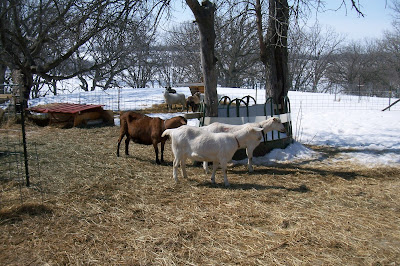Spring Break is over and we are back in class. The semester is quickly coming to an end. We only have two more weeks of class for the SFP program. Our last week is the week of April 1, which is hard to believe with all the snow still on the ground. We don't have formal finals as everyone will be starting their internships prior to the official finals week. What we dohave are final papers, lots of reading assignments and reports in all classes.
 |
Even though it is a long, cold, snowy winter the Winter Greenhouse at
Paradox Farm keeps producing plenty of salad greens for the supper table.
I believe those might even be some started tomato plants at the far end. |
 |
85 degrees in the
Winter Greenhouse |
For the week of March 18, 2013 in Grass Based Livestock class we continued our pre-break lecture on Paddock Layout considerations: Similar soil type, similar topography, slope and aspect to sun, similar forages. Also need to take into consideration sensitive areas like timber, native prairie remnants, steep slopes, wetlands, springs, rivers and flooded areas. A good free resource book on pasture design is the Minnesota Department of Agriculture's (MDA) Publication "Improving and Sustaining Forage in Pastures" June 2010, by Howard Moechnig. I believe this book is available electronically from MDA. This lecture also revisited some of the cover- cropping from last semester's "Crops & Forage" class, with the addition of using animals to harvest the cover crops to increase generated revenue. Following the cover crop discussion we had guest lecturer's Dr. Wika and Dr. Prive from Paradox Farm discussing small ruminants, how they might fit into farm and holistic goal. Small ruminant livestock are basically sheep and goats. Sheep like grass and eat down and goats like broad-leaves and tend to eat up (shoulders and above). Both can be used for dairy and draft animal work although goats are much more commonly used for those purposes.
Goat and Sheep Terminology
A
Buck is an intact male goat and a
Ram is an intact male sheep.
A
Wether is castrated male goat or sheep. Typically butchered at 4 to 8 months of age.
A
Doe is an female goat. A
Ewe is a female sheep.
A
Kid is a baby goat. A
Lamb is a baby sheep.
 |
| New born lambs at Paradox Farm |
The class then went into a discussion on livestock gestation (how long various animals take to carry a baby to full term) and using that knowledge to plan when to breed your animals so they have to young at the most opportune time of the year. Typically spring in order to work with nature instead of against it.. Following that the class finished by covering the topics of "Pasture Fertility Management" and then Mulit-Species Grazing. (The MDA book previously mentioned is a good reference for both of these subjects as are "The Stockman's Grass Farmer" and "Graze" publications.
On Friday in Sociology of Agriculture class we turned in our assignments, reviewed the reading questions, and had our seed quiz. The most important of the assignments was the Livestock Auction Paper (discussed in a previous post). This paper was worth 100-points or about 1/3 of the grade for the class. If you ever get to do this program make sure you do this paper and do not put it off until the night before to finish it. Also make sure you take very good notes during your visit to the livestock auction.
We then had a special guest lecture Duane Ninneman, Sr. Director and director of Climate and Energy with CURE. Duane told us a little about what he does, some of the various efforts he has been involved in and some about is farm "Borrowed Farm". On his farm he allows other people to come out and have "Allotment Gardens" where they can stay and camp and tend their gardens. Sort of a commune/co-op type of farm. Duane's primary topic of discussion was on making change.
After Duane's talk we jumped into Farm Marketing and Management talking about risk assessment, financial management and business structure. From there we discussed the various forms of organizational structure: Sole Proprietorship, Partnership, Corporation, Limited Liability Corporation (LLC), and a Cooperative. The lecture also included how to register a business in Minnesota, and some options available for Finance Alternatives and Financial Assistance for beginning farmers. After a brief break we got into specifics on Preparing our Business Plans, which is our final project for this class and comprises the majority of the grade for the class. A typical outline for a business plan includes the following:
Cover / Executive summary, Mission / Vision Statement, Goals and Personal History, Business Strategy, Performance and Market Assumptions (market research information), Risk Analysis / Contingency Plans to mitigate risk and Financial Statements. The assignment for next Wednesday's make-up class is to complete a draft business plan or at least an outline.








































